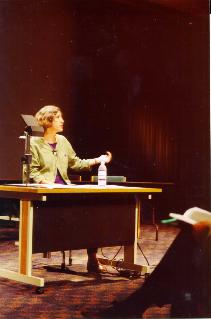

Lucy Suchman
These remarks were made at the WPT fest and are not intended for redistribution. Please do not quote without permission of the author.
One inspiration for us in organizing this gathering was the prospect of bringing our various, partially overlapping networks of friends and colleagues interested in work and technology together in one place. So in discussing how best to welcome you all we decided that we had better begin by introducing you to each other. Rather than have you turn to your neighbor and shake hands, or go around the room and have each of you tell your story (though lord knows that would be a fascinating event in its own right), we decided that I should adopt the Danish practice at a large celebratory gathering, wherein the host explains to their guests who don’t all know each other how they all came to be there. In this case the relevant kinship ties are intellectual ones, so I’ll try to do that by providing a kind of orienting map of the intellectual landscape that we collectively represent.
This is obviously an assignment fraught with potential for all sorts of shortcomings, so I’ve decided to approach it in a particular way. Rather than make any attempt at comprehensiveness, I’ll try to name some of the research affiliations represented here and give an example for each of the kinds of concerns and insights that animate it. Or, more accurately, of the kinds of concerns and insights that have animated and inspired us in our own work over the past two decades. With that as background I’ll then say a few words about how our work here has tried to weave some of these affiliations together, and by then I hope we’ll have some context for the panels and discussions that will occupy us for the rest of the day.
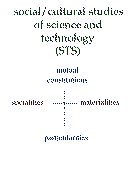
So, to begin with at least some of our beginnings, I’ll take the broad category of investigations that have gone on under the name of social and cultural studies of science and technology or, more recently and succintly, technoscience studies. Coming together (as did so many things) in the 1960’s, STS has been a wonderfully rich and eclectic home for researchers — primarily anthropologists and sociologists — interested in the sociality of science and technology and in the materialities of the social world. Among the many achievements of STS has been a radical re-examination of traditional boundaries, particularly in the European west, between the categories of nature/culture, social/technical, and human/artifact. The project has become one that might be thought of as recovering the relations along one dimension, and restoring the excluded middles along the other: for example, by recognizing the deep mutual constitution of humans and artifacts, without losing their particularities and differences.
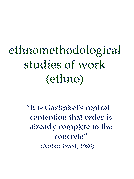
For many of us here, a particularly compelling agenda for the study of work and technology is provided by ethnomethodology. Ethnomethodology proposes a radically alternate program for social studies that flies in the face of what Harold Garfinkel has aptly named "the worldwide social science movement and its armies of social analysts." Rather than seeing the specificities of the lived world as in need of analytic reworking — into generalizations, abstractions, formalizations and the like — that then order and explain the concreteness, ethnomethodological studies take as their topic just how, specifically, the work of ordering (including but not limited to its technologies of analysis) gets done. Ethnomethodological studies now make up a rich corpus that respecifies the grounds for the orderliness of everyday activity, including work practice across a range of shop floors and employing various assemblages of associated artifacts.
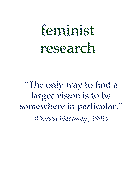
Having in common with ethnomethodology a commitment to the specificities of embodied practice and lived experience, feminist studies have been another powerful force in re-working our traditional investment in formal analysis as the foundation of social theorizing. Beginning with the project of denaturalizing and refiguring gender — from an eternal, biological category to specifically situated, historical and cultural productions — feminist research has worked to find alternate bases for responsibility and accountability as well. Rather than requiring some kind of transcendent, omniscient view from outside, responsible action is taken to work through, and only through, engagement with the contingencies and contradictions of our particular, always shifting positionings.
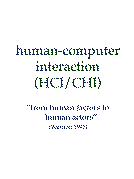
Turning to the interests in technology represented here, I’ll start with the field of human/computer interaction. With primary roots in psychology, HCI has been the traditional home for those whose interests in computing center on the peripheral (for academic computer science) questions of just how the encouter between person and computer artifact is to be managed (and by whom). A persistent fault line within HCI has run between those interested in the prospects for the interface as intelligent interlocutor (affiliated with artificial intellgience), and those for whom the computer remains a dynamic artifact to be designed (affiliated with the traditions of graphical and industrial design.) More recent critiques, e.g. by Bødker, Bannon and others, call for a refiguring of the relevant field of research in HCI from the interface narrowly defined, to the situations of use and ongoing activities in which our interactions with computer artifacts are embedded.
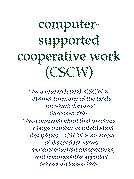
One research community in which such a refiguring has taken place is CSCW, initiated in the mid-80’s out of practical concerns regarding the advent of networked computing and the implications of multiple, distributed computer users for system design. CSCW has since become a forum for those interested in the design of computer-based technologies with explicit concern for the socially organized practices of their users. As a consequence, CSCW has also become a kind of haven for computer scientists and social scientists interested in the possibilities for hybridization of their respective fields. Most notably for the social scientists among us, CSCW has been a place where extended studies of complex, multi-activity, technology-intensive worksites have found an eager audience among computer science colleagues as well as, increasingly, a place to report our hybridized collaborations in work-oriented, practice-based system design.
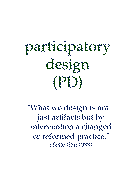
Finally, many of us here have come together through our shared interests in developing an alternative to mainstream system development practice that re-positions traditional relations of design and use. In place of a model of expert technologist delivering what’s good for him or her to novice user, initiatives under the heading of participatory design take a radically symmetrical view of the knowledges related to work and technology design. In particular, knowledge of relevant work practices is taken to be at least as critical to the design of new technologies as is technological expertise. This means that technology design needs to take the form of a process of mutual learning around a joint project, located within the site of prospective technology use. This process, moreover, is inevitably a political and interested one. In recognition of that, the Scandinavian roots of participatory design bring as well as an explicit commitment to values of skill enhancement, quality of working life, and industrial democracy.
As I said at the outset this is only a gloss of the intellectual resources represented in our collectivity — to this could be added, among others:
But with that brief (and idiosyncratically selective) sampling of who we collectively are as background, let me now turn to sketch something of what’s gone on here over the past 20 years: how we’ve tried to weave these various resources into our own practice. As you all know, it was in the late 1970's that a small cohort of us here at PARC — anthropologists and computer scientists — began developing a joint research program concerned with the ethnographically-based study of everyday work practices and with associated projects of design. I’ve recently taken to talking about our agenda as, among other things, the reconstruction of technologies as social practice. I like this phrase in part for the ambiguities of the term reconstruction. Let me say a bit more about that.
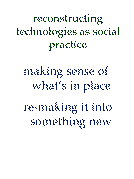
The first sense of reconstruction references the work of documenting or, in ethno’s happier phrase respecifying, culturally and historically constituted meanings and practices. In this sense the question is how to conduct ethnographies of work and technology, including both practices of design and artifacts-in-use, that are aimed at recovering the projects, identities and interests that inform those practices. These reconstructions are about making sense of what’s in place. The second sense points to a more reformist agenda, aimed on the one hand at critical analyses of the professional practices and institutional arrangements of contemporary technology production, and on the other at possibilities for the development of alternative approaches. These reconstructions are about re-making what’s in place into something new. Both comprise substantial projects: projects that we take to be intimately and necessarily interrelated.
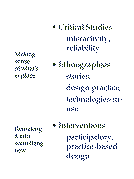
Within that frame, we’re interested more specifically in three increasingly hybrid approaches. First, within the project of making sense of what ‘s in place, are critical studies of prevailing discourses and practices in the production of new technologies. For example, our early work looked critically at notions of "interactivity" and "reliability" as those terms have been taken up within the fields of product design and technical service work. Second, again as a contribution to making sense of what we have, we need ethnographic inquiries into specific sites of work. Here we take as illustrative the place of stories, the work of design, and the study of technologies-in-use. And finally, in the interest of re-making what we have into something new, we need interventions into processes of work and technology design aimed at the development of alternatives to prevailing practice. For us that’s taken the form of explorations in what I’ll call here as a shorthand participatory, practice-based design. I’ll say a bit more about each of these in turn.
Arriving at PARC in 1979 as a graduate student in anthropology with a strong interest in human interaction, I was intrigued by the ways in which the notion of interaction was being applied to relations between people and machines. It seemed to me that the challenge of interactive interface design was actually a more subtle and interesting one than it was assumed to be by my colleagues. Basically their assumption was that computational artifacts just are interactive, in roughly the same that way persons are, albeit with some obvious limitations. However ambitious, the problem in this view was a fairly straightforward task of encoding more and more of the cognitive abilities attributed to humans into machines, in order to overcome the latter's existing limitations.
Around this time a project began at PARC to develop an intelligent, interactive expert system that would provide instructions to users in the operation of a particular photocopier, just put on the market and reported by its intended users to be "too complicated." With Austin Henderson, I initiated a series of studies aimed first at understanding what made the existing machine difficult to use, and later at seeing just what happened when people engaged in "interactions" with my colleagues’ prototype expert advisor.
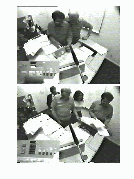
In order to explore these questions in detail we got a machine ourselves and installed it in our workplace. I then invited others of my co-workers, including some extremely eminent computer scientists, to try using the machine to copy their own papers for colleagues, with the understanding that a video camera would be rolling while they did so. This resulted among other things in what has become something of a cult video that I produced for John Seely Brown for a keynote address to CHI in 1983, titled "When User Hits Machine." This image, taken from a 3/4" reel-to-reel video recording made in 1982, shows two of my colleagues using the machine to make two-sided copies of a research paper. The CHI audience would recognize Allen Newell, one of the founding fathers of AI. His PARC colleague is a brilliant computational linguist named Ron Kaplan.
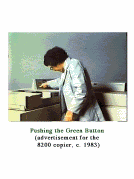
From looking closely at actual encounters with the machine, I began to develop the idea that its inscrutability was less a function of lack of technological sophistication on the part of its users, than of their lack of familiarity with this particular machine. I argued that the machine's illegibility was tied not to any esoteric technical characteristics, but to mundane difficulties of sense-making characteristic of any unfamiliar artifact. My point was that reading a new artifact is an inherently problematic activity. I wanted to argue that however improved the machine interface or instruction set might be, this would never obviate the need for learning on the part of prospective users. This called into question, then, the very viability of marketing the machine as self-evidently easy to use.
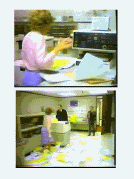
My colleague Jeanette Blomberg arrived around this time, and was given an assignment that invited a related look at assumptions about machine "reliability." We’ll call on another moment from the video "When User Hits Machine," borrowed from the movie "9 to 5," and have Jane Fonda set the scene for Jeanette’s work. In this episode Jane, on her first day at work, has been instructed by hyper-efficient office manager Lilly Tomlin in the operation of a very large Xerox copier. Predictably, the moment Lilly leaves the room and Jane presses the big green button, all hell breaks loose. And, at the worst possible moment, she is discovered being incompetent by her brutish boss, who tells her that "any idiot can operate this machine," and that if she doesn’t get it together her first day might be her last.
Product developers and marketers at Xerox in the early ‘80’s were puzzled by a lack of correlation between the frequency of machine service calls and "customer perceptions" of machine reliability. The expectation had been that as service calls increased, perceptions of reliability would decline, while a machine with few service calls should be seen as highly reliable. Instead it seemed that machines assessed as good performers by the company were pronounced "lemons" by their users, while others requiring frequent service calls were well-loved. Many explanations were suggested for the lack of correlation, chief among them being the idea that machines developed reputations that persisted despite the measurable behavior of the machine.
Jeanette suggested that a closer look at the actual circumstances of machines-in-use might be needed to understand what was going on. Her studies showed that the "same" events measured by the company could be experienced in radically different ways by machine users, depending on just how those events were embedded in a specific worksite and course of activity. So for example a paper jam encountered with a knowledgeable person nearby to consult on how to clear it might be experienced by few and quickly forgotten, while the same paper jam encountered at 5:00 by a harried worker unfamiliar with the machine and with no one else in sight would be experienced as a major breakdown. The boundaries of the machine, in other words, were reconfigured by Jeanette’s work to become less defined by the box, more contingent on its relations with its environment.
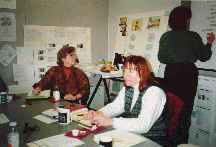
This expanded view of the machine’s place in its environments of use became the basis for a long and fruitful relationship with a small band of product designers inside Xerox, first in the Industrial Design/Human Interface group, later distributed throughout the product organizations as well as in research, for whom Jeanette became both friend and mentor.
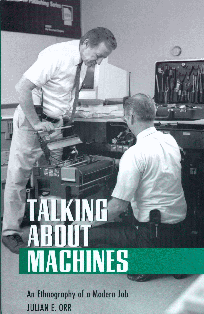 | 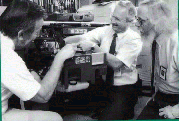 |
A next major project was initiated by Julian Orr, this time in response to corporate concern over the training of service technicians. Cognitive scientists on the research staff construed the problem as one of crossing the novice/expert divide, changing the mental models of novices to match those of experts. Julian began a study of expert technicians, trying to characterize expertise in the field. While the corporation assumed the work of technicians to be the rote repair of identical broken machines, Julian found this to be a gross oversimplification. He argued that the work was better characterized as a continuous practice of improvisation within a triangular relationship of technician, customer, and machine. Individual machines are idiosyncratic, with different histories of use and modifications, and set in different social contexts, all of which affect their performance. Service calls are occasioned by a problem in the relationship between user and machine, and while the machine may need repair in itself, fixing the relationship is essential to the satisfactory completion of the service call.
During an observed diagnosis, moreover, Julian noted that the technicians were exchanging stories about earlier diagnoses and misbehaving machines from the past. When looked for, stories seemed to be everywhere in technicians' practice. In fact, Julian discovered that narrative is a primary element of their work. More specifically, diagnosis involves the creation of a coherent account of the problematic machine, pieced together from the available, unintegrated facts. These narratives are repeated to colleagues so that accounts created for diagnosis circulate in technicians' discourse, distributing the technicians' experiential knowledge throughout the community. These stories are also a critical part of the social life of the community, as technicians demonstrate and share their mastery of the domain, and in doing so celebrate and create their identities as "masters of the black arts of dealing with machines and of the only somewhat less difficult arts of dealing with customers. " (ibid., p. 2) Julian’s work formed the basis for interventions, first with radios and later w/"Eureka," currently heralded as Xerox’s major platform for "knowledge-sharing."

The black arts of networked software design are the topic of another major ethnographic project by Susan Newman. Starting with an actor network perspective, Susan's project has been to enrich that perspective with a view from inside the lived work of designing social/technical networks - in this case, the design of networked software known as "middleware." In her words, "this perspective views software development as not only an activity undertaken by people acting collaboratively or in other relations with each other, but also one that imaginatively and materially constructs a social world populated by objects, actors and relations, in and as the course of producing an artifact." The course of design work in Susan's observation involves the mutual stabilization of the technology-under-development and the network of interested actors, through a process that is endlessly dynamic as networked relations shift and unfold. She argues, moreover, that the relations involved are multidimensional, accountable and frequently contradictory, in ways that have not been adequately thematized in social studies of science and technology.
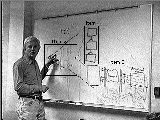
Susan suggests that a central method of sociotechnical design work is what she calls "techniques of virtuality," that is, to quote her again, "performative practices including talk, textual-graphical productions, and enactments or animations, though which developers bring into the present and into immediate, lively juxtaposition elements that are otherwise distributed in time and space." Her formulation sheds light on the findings of an earlier project in a very different setting, aimed at developing both our theoretical and methodological resources for analyzing work and technologies-in-use.
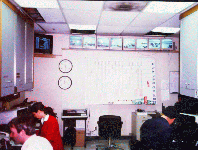
I won’t begin to do justice to the project here — many of us were involved in it, including Chuck and Candy Goodwin . This was a project known as the Workplace Project, which was about looking at technologies-in-use in their actual work environments. We went out to find a multi-activity, technology-intensive environment, and ended up in the operations room of a local airport — the place where all of the work of ground operations is coordinated. Given the limits on my time this morning, I’ll give you just one of the morals of that story.
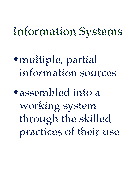
Basically, our study of the operations room led us to a substantial reconceptualization of what actually constitutes an "information system." Rather than a very large workstation that encompasses more and more of what you want to know, or even a network of workstations in which information is stored, our analysis showed information systems to be made up of a multitude of partial, fragmented, information resources, which through the skilled practices of people making use of them could be related, juxtaposed, read against each other and in relation to an unfolding situation, and thereby turned into a working information system. The system is, in other words, this irreducible assemblage of artifacts and the practices of their use.
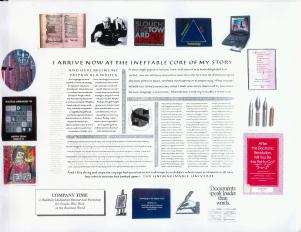
This appreciation for the deeply relational character of information resources has formed the heart of David Levy’s work on the document, where the relevant relations are not only work and technology, but continuities and discontinuities across time and across disciplinary boundaries. David has worked to clarify the relations between historical and contemporary document practices, and between handcraft — e.g. calligraphy and book-binding — and mechanical practices. At the same time he is know as a translator between the computer science and library communities, addressing issues such as cataloging, preservation, document standards, and re-use as common concerns, but often very differently conceptualized and practiced across the fields. Finally David has done much to de-bunk the breathless hype of the digital, providing a more nuanced analysis of the actual continuities and transformations of new media and what it means to live and work with and through them.
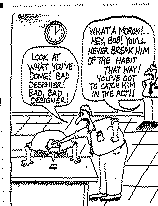
Studies like these suggest that rather than discrete moments of production and consumption, technology-intensive work practices involve complex relations of appropriation and reworking across sites of professional design and design-in-use. This brings us to our final agenda, that of interventions into practices of professional work and technology design. Here’s one model of what might be the problem with existing design practice. This cartoon takes the problem of inadequate technology design to be one of individual behavior, requiring retraining. Instead, we see the problem in terms of the social arrangments and institutions through which design gets done. Even designers who’d like to have a closer relation with situations of technologies-in-use find themselves in working arrangements that make it very difficult to do so. That means that rather than an intervention aimed at changing individual behavior, ours is really a project of social change.
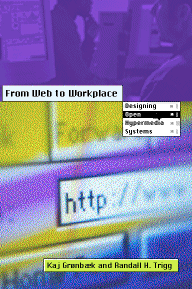
We were able to take on that project directly, at least in a small way, beginning in the early ‘90’s thanks to our developing relationship with many of you in this room working on new forms of system development. Around this time as well Randy Trigg, who had cut his ethnographic teeth on the Workplace Project, rejoined us after a stay in Denmark, bringing both rich personal experience in the practice of participatory design as well as an extensive background in the design of hypermedia. Inspired by Randy’s return, we decided to attempt to practice what we were beginning increasingly to preach.
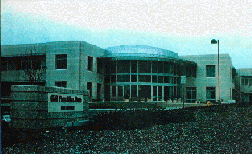 Law firm | 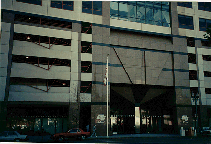 Caltrans headquarters |
Our own projects in practice-based, work-oriented design had to be organized in particular ways given our positioning here at PARC. Most obviously that meant an orientation to document-related work practices on the one hand, and to technologies aimed at translations across paper and electronic media on the other. First in a law firm, and most recently with a team of civil engineers designing a bridge, we’ve worked across what in some respects are incomparable sites of work and technology. In both of these sites our research has involved intensive engagement with the specifics of the work and its contingencies — in part these projects for us are an occasion for workplace ethnography that extends beyond our particular design agenda.
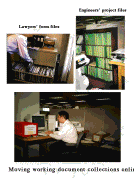
At the same time, our projects are also very much about seeing how studies of work and cooperative design can be woven together, through the mediating practice that we call case-based prototyping. And we’ve identified a consistent design focus across these projects; that is, on what we’ve come to call working document collections and the requirements and possibilities for moving them online.
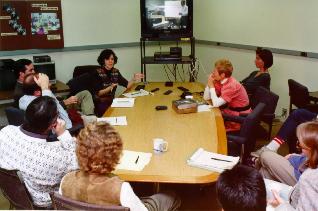
Now while Jeanette, Randy, David and I have been toiling in the fields of participatory system design, Gitti Jordan has been taking practices of participation in a somewhat different direction. Growing out of her longstanding commitment to interaction analysis as a way of recovering the details of how people work, she has organized and championed collaborative Interaction Analysis Labs both at PARC and IRL, as well as at universities like the Johannes Keppler University in Austria and the University of Illinois . One of the core concepts that has developed out of Gitti’s work is the notion of "authoritative knowledge," particularly in its relations to technology. Recognizing that those who do the work often are allocated the least authority, Gitti has pressed to incorporate participants themselves into the process of work analysis, e.g. workers' IALs in the context of a major organizational assessment and development project inside Xerox (aka the Work Practice and Design Project).
So there’s the last 20 years for us. The question that we want to take up today is "Where do we go from here?" And by "we" in this context I mean not only those of us who’ve been part of the Work Practice & Technology group. As most of you know, our futures will no longer be quite so intertwined, as we attempt to find various new venues that will allow us to pursue these lines of research. "We" in this context is all of us, the collective: maintaining connections not only to each other but to those of you with whom we’ve worked over the past 20 years is our primary concern. At the same time, our twenty-year time frame is meant somewhat ironically. We’re not futurologists, and we take seriously the words of Haraway quoted earlier, that "the only way to find a larger vision is to be somewhere in particular." Our discussions, in that spirit, are meant to reference our current projects as a basis for imagining what could come next. Our set of topics, moreover, is meant not to be definitive, but as the first three in an open-ended list, to be extended through our discussions today and in the workshop that follows.